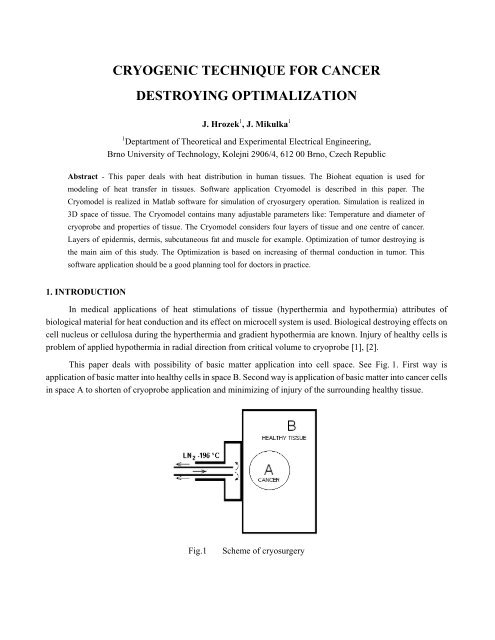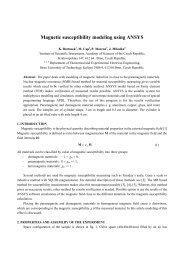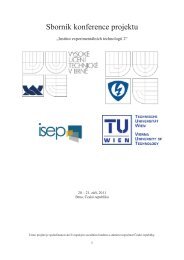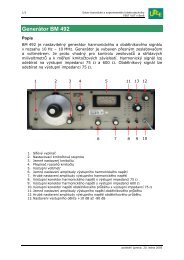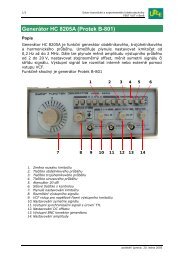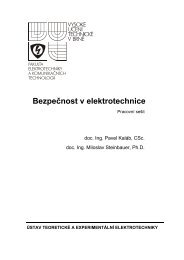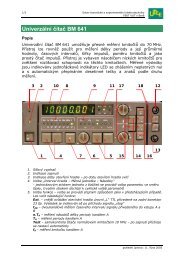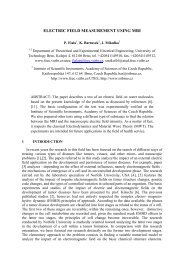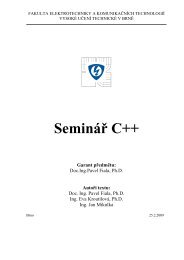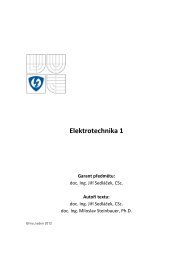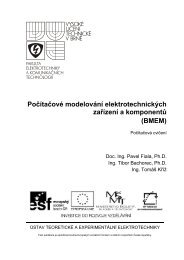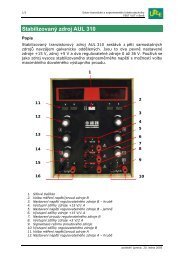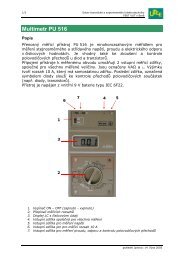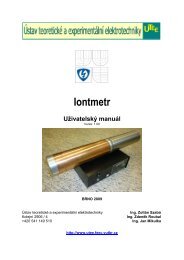A Simple Template for PIERS Full Papers - UTEE
A Simple Template for PIERS Full Papers - UTEE
A Simple Template for PIERS Full Papers - UTEE
- No tags were found...
You also want an ePaper? Increase the reach of your titles
YUMPU automatically turns print PDFs into web optimized ePapers that Google loves.
CRYOGENIC TECHNIQUE FOR CANCERDESTROYING OPTIMALIZATIONJ. Hrozek 1 , J. Mikulka 11 Deptartment of Theoretical and Experimental Electrical Engineering,Brno University of Technology, Kolejni 2906/4, 612 00 Brno, Czech RepublicAbstract - This paper deals with heat distribution in human tissues. The Bioheat equation is used <strong>for</strong>modeling of heat transfer in tissues. Software application Cryomodel is described in this paper. TheCryomodel is realized in Matlab software <strong>for</strong> simulation of cryosurgery operation. Simulation is realized in3D space of tissue. The Cryomodel contains many adjustable parameters like: Temperature and diameter ofcryoprobe and properties of tissue. The Cryomodel considers four layers of tissue and one centre of cancer.Layers of epidermis, dermis, subcutaneous fat and muscle <strong>for</strong> example. Optimization of tumor destroying isthe main aim of this study. The Optimization is based on increasing of thermal conduction in tumor. Thissoftware application should be a good planning tool <strong>for</strong> doctors in practice.1. INTRODUCTIONIn medical applications of heat stimulations of tissue (hyperthermia and hypothermia) attributes ofbiological material <strong>for</strong> heat conduction and its effect on microcell system is used. Biological destroying effects oncell nucleus or cellulosa during the hyperthermia and gradient hypothermia are known. Injury of healthy cells isproblem of applied hypothermia in radial direction from critical volume to cryoprobe [1], [2].This paper deals with possibility of basic matter application into cell space. See Fig. 1. First way isapplication of basic matter into healthy cells in space B. Second way is application of basic matter into cancer cellsin space A to shorten of cryoprobe application and minimizing of injury of the surrounding healthy tissue.Fig.1Scheme of cryosurgery
Fig.2The running application“Control panel” section contains controls of simulation like Run, Save, Load and others. Check box "Setthreshold" enables to see the region of killed cells (temperature below -13°C) only. User can select slice position(x means, that x = position of slider and y, z are from 1 to x dimension, z dimension). Button "Show C.R." showscooling rates in defined depths 1, 2, to, 9 mm. Condition of cooling rate about 200 °K.min -1 is necessary <strong>for</strong> goodfreezing process during the cryosurgery. “Show D.O.C” displays temperature dependence on depth.In “Parameters of simulation” section is possible setup temperature and diameter of cryoprobe, dimensions of 3Dmatrix, layers and globe of tumor, time step, edge of voxel, threshold and time of during the simulation. TheCryomodel considers four layers of tissue and globe which represent a tumor. Setup of layer 4 is used <strong>for</strong> whole3D matrix if the popup menu "Layer" is set on "4".The “Properties of tissues” section consist density, thermal conductivity, specific heat, blood perfusion andmetabolic heat generation. For each of four layers is possible select type of layers from popup menu and determinestability of simulation.
3. OPTIMIZATIONThe main goal optimization of tumor destroying is based on increasing of thermal conductivity anddecreasing of specific heat in tumor. In this case is higher drain of heat from tumor and time of cryoprobeapplication is shorter also. Healthy tissues are then less injured. Only the theoretical hypothesis is described in thispaper. The globe of tumor is filled with thermal properties of optimized tumor. Surrounding space is filled withthermal properties of human tissue in four layers, epidermis, dermis, subcutaneous fat and muscle in this case.Average thermal conductivity of human tissue is about 0.5 W.m -1 .K -1 and average specific heat is about3600 J.kg -1 .K -1 . Results of simulation with optimized tumor are shown bellow on Fig. 3.EPIDERMISDERMISSUBCUTANEOUS FATMUSCLETumorEPIDERMISDERMISSUBCUTANEOUS FATMUSCLETumora) AB b)Fig.3 a) Results of simulation after 1 s. b) Displayed only region bellow -13 °C.We can see that area inside of globe of tumor is frozen much more then healthy tissue in the same depth. Right sideof Fig. 3 displays only region with temperature bellow -13 °C. White lines display layers of tissue model andwhite circle displays globe of tumor. The same results are evident from Fig. 4.On left side of Fig. 4 are displayed temperatures dependences of time in defined depth 1, 2, to, 9 mm. The coolingrate (gradient) 200 K.min -1 is displayed like dotted line and temperature bellow -13 °C is displayed like dashedline. The cooling rate 200 K.min -1 and temperature bellow -13 °C simultaneously are the main conditions of totalcells killing.On right side of Fig. 3 we can see temperature dependence of depth in axes of cryoprobe. Temperature bellow-13 °C is displayed like dashed line and depth with temperatures bellow -13 °C is 1.7 mm.
4 mm3 mm2 mmx: 1.7 mmy:-13°C1 mm4. CONCLUSIONSa) b)Fig.4 a) Cooling rates <strong>for</strong> defined depths. b) Depth of cooling after 0.01 s.This model study is based on finite difference method and numerical solution of Bioheat equation by Mr.Pennes (1948). The Cryomodel application has been tested <strong>for</strong> some properties of human tissue and has beencompared with result from real experiment with potato. Only the model situation is describe in this paper. Forconfirrmation of theoretical hypothesis the parameters of optimmized globe of tumor has been used. Next researchwill be focused on real experiments. The aim is to find a procedure of real tumor and wart destroying optimization.ACKNOWLEDGEMENTSThe research described in the paper was financially supported by FRVS (a fund of university development)by research plan No. MSM 0021630513 ELCOM, No. MSM 0021630516 and project of the BUT Grant AgencyFEKT-S-10-13.REFERENCES1. CHO, Y. Bioengineering Heat Transfer : Advances in Heat Transfer. London: Academis Press Limited, 1992. 443 s.ISBN 0-12-020022-8.2. ZHMAKIN, Alexander I. Fundamentals of Cryobiology : Physical Phenomena and Mathematical Models.Berlin : Springer, 2009. 280 s. ISBN 978-3-540-88784-3.3. AKAY, M. Biomedical engineering: Volume 1 and 5. John Wiley and Sons, 2006. Hoboken, New Jersey ISBN-13:978-0-471-24967-24. POLANKA, M. Technical Experiment Based Inverse Tasks in Mechanics [s.l.], doctoral thesis FSI VUT 2006. 141 s.5. SCHMID, G, et al. Bestimmung der Expositionsverteilung von HF Feldern im menschlichen Körper, unterBerücksichtigung kleiner Strukturen und thermophysiologisch relevanter Parameter. 2008. Bundesamtes furStratenschutz 38201 Salzgitter, Deutschland, 129 s. ARC-IT-0174.


